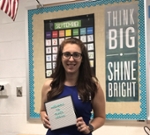
Kathryn Himes
W&M, 2014
Fields of Study:
M.A.Ed. Curriculum & Instruction - Secondary Mathematics; Mathematics (B.S.) and English (B.A.)
Teaching Focus:
Pre-Algebra, Algebra, Geometry, Algebra II, Honors Trigonometry, Pre-Calculus, Calculus AB
Teaching Assignment:
Elkton High School in Cecil County Public Schools in Elkton, MD
Describe your current teaching assignment:
Currently Teaching: 2 sections of Co-taught Algebra I; 2 sections of Geometry; 2 sections of Honors Trigonometry. Currently Coaching: Cheerleading
How did the Noyce program prepare you for this assignment?
I have worked in 4 different states since graduating from The College of William & Mary. Each school district I have worked in has been classified as title I or a state's similar classification. Each time I have worked with over 70% free or reduced lunch, and one school district was 100% free breakfast and lunch. Several of my students experience extreme poverty, are exposed to sex and drug trafficking, or are a part of "underground homelessness." Noyce helped to show me what I would come into contact as an educator, how to respond to students who were experiencing hardships, and how to give them the education they needed at the level they were at.
How did the Noyce program at William and Mary prepare you to use teaching strategies that can help all students learn in all settings?
The Noyce program at William and Mary utilizes real experiences and school visits to instill the value that all students are deserving of an education and have the ability to succeed. This mindset applies to students with disabilities, students of poverty, and students of trauma (among others). Throughout my teaching career, I have used this mindset to fuel my lessons, to fuel the way that I chose to teach mathematics, and to fuel the extra help I offer my students. I determine where my students start when the enter my classroom and how I can best support them throughout their mathematical journey. Sometimes this is through additional practice, but most often this is through hands on lessons that involve manipulatives of sorts. This helps to make mathematics real to my students.
How do you use what you’ve learned (content and pedagogy)?
Noyce instilled in us that every student is deserving of an education and has the ability to succeed no matter their background. I use this mentality daily and offer additional time to all of my students where they can recap and understand the material more thoroughly through one-on-one sessions. I offer time after school as well as during my planning to accommodate students who work multiple jobs to help support their family. Last school year, I worked with a student who was blind and had a TBI. This student was placed in my year long Algebra I course but was working at a 3rd grade level in Mathematics. She is incredibly gifted with numbers and can do calculations in her head once she understands the basics. I worked with her almost every day to build her confidence in mathematics and get her to a place where she felt more comfortable with what we were learning. We used manipulatives and geoboards show she could visualize the shapes and movements of graphs. She may have had a disability that hindered her ability to see with her eyes, but she was able to see the graphs with her hands.
In addition to teaching, are you exploring new areas in content, teaching strategies, leadership, etc. If so, what areas and did the Noyce experience play a role:
I was an integral part of the AdvancedED accreditation team last year and was instrumental in authoring the narrative for "Implementation Capacity." (Defined as: A focus at our school is to make expectations clear for all stakeholders and supply all stakeholders with the means to achieve these expectations.) Without the experiences and lessons I learned from Noyce, I would not have fully understood the importance of this team and the documentation necessary to adequately showcase what our school was doing to create equity for all students.
Describe any highlights/special achievements during these beginning years of teaching:
In my first year of teaching, I was recognized for the percentage of students who passed the STARR in Texas. Because of this, my principal felt confident in my ability to teach dual credit and advanced placement courses. During year two and three, I received the "Growl Award" at my school for extraordinary excellence and dedication to Paris High School while working towards a second Master's degree in Mathematics. During year four, I was given the opportunity to attend a Carnegie Algebra I year long training to better serve my students in Georgia. Now, as I am finishing my sixth year in Maryland, my principal has asked me to look into AVID and consider going to multiple trainings this summer.
What has the Noyce program meant to you?
The Noyce program was and has been a source of assistance, professional development, and networking with colleagues during and after graduate school. This was and still is an experience that I feel helps to fuel who I am as an educator.
 Skip to main content
Skip to main content
